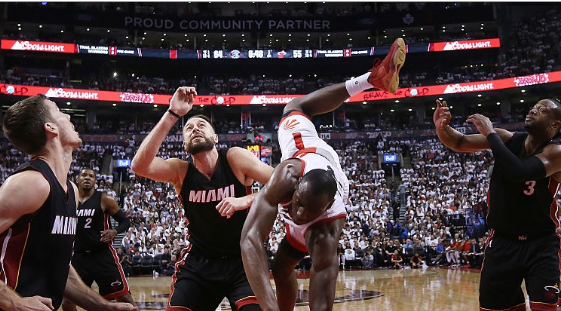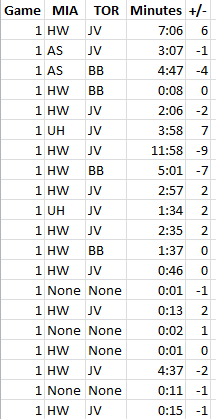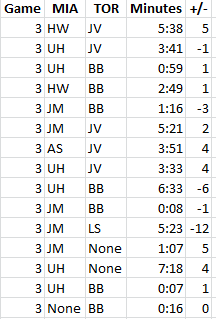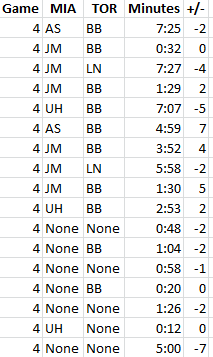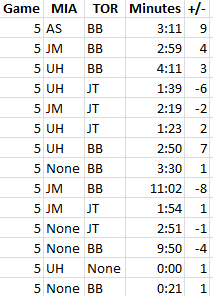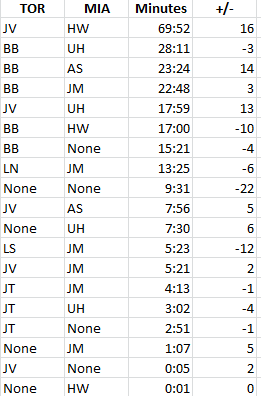One of the major talking points coming out of Game 4 was the Toronto Raptors’ insistence on matching small with the Miami Heat in the stretch run. The Heat’s center-less lineup thrived against the lack of rim protection with Bismack Biyombo on the bench, outscoring the Raptors by 14 in just 10 minutes of action. This was a little surprising, given how the Raptors match up on paper with a small group, but small-against-small groups see the Raptors give up size at every position, and they didn’t switch aggressively enough or defend the point of attack capably enough to make up for the lack of back-end help.
In Game 5, Dwane Casey was more willing to stay big, playing Biyombo for 38 minutes. Once again, the Raptors were better with Biyombo on the floor (he’s now a team-high plus-26 since Jonas Valanciunas went down hurt), and the traditional Biyombo-Patrick Patterson pairing thrived again (they’re a plus-29 as a duo in 61 minutes over the last two games).
Casey deserved credit for altering his approach, but instead of suggesting the Heat should match big, the way the game played out actually suggested the opposite. Despite losing the game and struggling overall opposite Biyombo, the Heat’s centerless lineups were still a plus-5 in 16 minutes. Essentially, over the last two games, the Heat have struggled when playing their three centers and remained competitive my virtue of their small groups.
This all poses interesting questions for both coaches heading into Game 6. Going small is complicated depending on the status of DeMarre Carroll and Luol Deng for their respective teams, but if each can go, the Heat may be inclined to go smaller earlier and more often. The Raptors will probably remain comfortable big with Biyombo on the floor, particularly with a lead down the stretch, but there’s also evidence to suggest that the Raptors should consider going small earlier in games – their own reserve centers have been ineffective, and the Raptors had some success going small earlier in the series.
The chess match between Casey and Erik Spoelstra as it pertains to the size of lineups is far from over.
For no real reason other than curiosity, I went back and logged the center matchups for each of the five games so far. I’m going to post the tables below and then make some notes at the end. Peruse for your interest and feel free to point out any interesting trends you see. I’m sure there are some I’m missing because my eyes glazed over doing this. (Note that I didn’t classify Jason Thompson or Luis Scola as “no center,” because I wanted to differentiate their time.)
It can be tricky to put all of the games together because of the differences in each game, the loss of the primary centers, not controlling for the other players on the floor, and so on. But if we isolate the centers, here’s what we get.
A few things stand out immediately: Valanciunas was winning the Whiteside matchup in the only one-to-one battle there’s significant data for, the Raptors are decidedly losing small-against-small battles, and both teams should probably retire a few center options (Scola, Thompson, Stoudemire). The most interesting note might be that the Raptors have been a minus-4 when Biyombo plays against small groups, but it’s important to remember context there – if the Raptors have a lead, a small net-loss might be tenable if it slows things down and puts defense ahead of offense.
It’s worth a reminder here that these are tiny, imperfect samples. I did this out of curiosity, not to draw any sweeping conclusions. How Spoelstra attacks the five-spot is the most intriguing storyline to watch in Game 6 for me, personally. Anything else stand out here?

